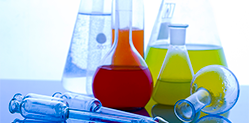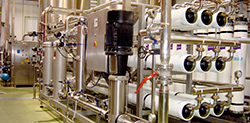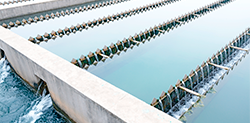Industrial sector
Paper and cardboard industry
.jpg)
The paper industry is a type of industry that has high water consumptionfor its production process. This is usedinproduction, refrigeration, transportation and other processes, which highlights the need to ensure and control the quality of process water to ensure the life of equipment and optimal production performance of the plant.
SERVYECO knows the regulations and the competitive needs of companies in the sector restrictions and offers customized solutions for the treatment of sewage, boilers, cooling circuits, osmosis ... in order to meet the needs of industry.
In recent years the paper industry has studied and implemented measures to reduce pollution levels, although in most cases the wastewater is treated by plants physicochemical purification with use of inorganic coagulants which leads to the obtaining sludge with high contents of heavy metals and high operating costs.
-
Solutions for wastewater treatment and reuse or disposal.
Advanced chemical products should are designed and implemented for a correct treatment of wastewater that allow them to obtain water of acceptable quality for discharge or reuse. SERVYECO has developed several products for an effective treatment. Coagulants of ECOMIX, SINTEC and ECOTAN series, cationic flocculants solid of ECOPOL CS series and cationic flocculants liquid of ECOPOL CL and ECOPOL CLR series, which will provide the following benefits:
- Higher percentage of solids separation which leads to a better output turbidity.
- Lower consumption of coagulants and flocculants in the debugging process.
- Less incorporation of salts in the treated water.
- Less quantity of sludge.
- Fewer odors.
-
Solutions for the water treatment process.
Servyeco has the necessary expertise to advise reduce operating costs, increase production efficiency and protect their equipment. Our services include the following chemicals:
- Chemicals for boilers: oxygen scavengers (CALTEC series), multifunctional (CALTEC series), passivating (CALDIX series).
- Chemical coolants: biocides (ECOCIDE series), anticorrosive (ECOMET series)
- Chemicals for reverse osmosis systems (ECOMET OI series).
Metal mining
Metal mining includes industries where silver, gold, nickel, aluminum, copper, iron, and other metals are extracted.
Mining operations by intensive use of water resources need comprehensive control of water consumption. Within this context and with the aggravating circumstance that usually mining operations are located in arid places with little or no access to water resources, low cost, are the need to capture water from desalination plants or transport it from the end of the production line , with consequent added pretreatment.
Mining requires a design appropriate treatment of water in the extraction process, particular characteristics of the nature of mineral, water needs and demands of the operating environment in which it operates. Currently for the treatment of this water SERVYECO is an expert in water treatment mine copper, zinc and lead industry in combining technologies for the treatment of feed water and other waters whose pollution originates in the process production and runoff: remnants of plant operation, liquid fraction of the sludge generated in the conditioning and purification of waste.
Servyeco offers specific solutions for the treatment of acid mine water from copper, zinc and lead. The stages of the treatment system include: sedimentation, sand filtration, activated carbon filtration, reverse osmosis and ultra filtration. In the process of physical-chemical treatment we will use coagulant chemicals ECOTEC, ECOMIX or SINTEC series as a substitute for the usual coagulant based iron or aluminum, to improve the removal of suspended solids and sulphates to improve the speed of sedimentation suspended solids in water use flocculants oF ECOPOL AS or ECOPOL AL series.
Servyeco has a number of products that can be used in a wide variety of mining and applications to extract different types of heavy metals from waste, impossible to remove by water treatment industries coagulation - flocculation. The ADIMET series is designed to remove divalent heavy metals from wastewater and process.
Non-metallic mining
Non-metallic mining is responsible for the extraction of minerals such as talc, kaolin, sand, silica, lime, etc.
After the washing step any material two major problems arise. On the one hand the treatment of sludge generated in the washing and other water recovery for recirculation. The common solution is obtained by installing a sludge trap, with proper preparation and dosage of flocculants solution which gets efficiently separating solids from water.
-
Solutions for wastewater treatment and reuse or disposal.
Anionic flocculants or ECOPOL AS or ECOPOL AL are able to flocculate and solid particles less than 63 microns. Flocculated solids are separated state quickly and completely surround water. Thanks to the high molecular weight flocculants ECOPOL series of very high settling velocities are achieved. This allows working with high-performance clarifiers without the need for large areas of clarification. The treated water has a high quality and can be recycled to the washing plant. The sludge generated present a very high solid concentration so can dehydrate by using filter presses.
Meat Industry/ Slaughterhouse
Meat industry as slaughterhouses, cutting plants or processing of meat products is considered one of the most contaminants in the food sector. Meat sector is an important consumer of water as cleaner, cooling, heating treatment, ingredient, etc. That great consume implies higher wastewater volume production. Thus, inlet water is discharge as wastewater after its use, excluding when is added as ingredient for a product or when evaporates. In fact, wastewater generation is an environmental key questionin the meat sector mainly associated with laundering operations.
There are higher differences in consume, quantity and charge between different types or meat facilities (poultry slaughterhouse, meat products production, etc.). However, several common characteristics can be observed in rates of high organic loads expressed in terms of COD or BOD. Wastewater of agricultural meat industry contains an organic charge more than ten times higher than urban wastewater, with rates relatively upper of COD and BOD.
The generation of wastewater is one of the environmental aspects more significant of meat industry, therefore elevated volumes generated as the polluting load associated therewith. Wastewater generates in slaughterhouse can represent between 80-95% of total consumed water.
The most significantly environmental parameters that relate to wastewater are suspended solids (SS), the organic load expressed as chemical oxygen demand (COD) and biological oxygen demand within 5 days (BOD5), fatty oils, nitrogen, phosphorus, salts and detergents and disinfectants.
-
Solutions for wastewater treatment and reuse or discharge
Our treatment programs use chemicals specialties toremove contaminant agents, to minimize handling costs and sludge removal, to improve effluent quality and encourage saving and recycling water. Servyeco has developed a coagulant and flocculant line that allows extract up to 95% of suspensed solids and probably 70% of biochemical oxygen demand through physical chemical treatment. That process consists in: conditioning or pretreatment of wastewater by incorporating synthetic coagulants ECOTEC series or natural ECOTAN BIO series coagulants and flocculants of ECOPOL CLR series to facilitate the sedimentation of suspended solids.
Natural coagulant use of ECOTAN BIO series will provide the following benefits:
- Lower operative costs
- There is not required the use of neutralizers
- There is not increased conductivity
- Lower waste quantity and a reduction of removal expenses
- Better environmental compliance when using products
- Not involve danger
- Better process efficiency
-
Solutions for the treatment of process water
Servyeco provides of specific products for the treatment of process water. We decrease operative costs, increase productive efficacy and protect your equipment. Our services include following chemicals:
- Chemicals for boilers: oxygen scavengers (CALTEC series), multifunctional (CALTEC series), passivating (CALDIX series).
- Chemicals for cooling systems: biocides (ECOCIDE series), anticorrosive (ECOMET series).
- Chemicals for reverse osmosis systems (ECOMET OI series).
Milk industry
.jpg)
The most important environmental problem of dairy industry is the generation of wastewater, due to the volume generatedand the pollutant load associated, basically of organic character. Most of the water consumed in the production process finally becomes wastewater.
Dairies can produce pasteurized or sterilized milk and dairy products such as cream, butter, cheese, yogurt or milk powder among others. The manufacture of some of these products produces more polluting discharges that only with the production of drinking milk.
Thus, the type of products elaborated in the production plant determines the characteristics of the wastewater. The cheese manufacturing tends to have greater load due to the generation of whey with high COD and brines with high conductivity. The cleaning and disinfection operations are essential to ensure food hygiene. They are frequent and consume a large volume of water to produce high load discharges. Such operations are carried out after completion of production batches or at certain times of the day.
We dispose of innovative technology of chemical treatment for wastewater with coagulants based in vegetal of ECOTAN. They represent the best option when ecologic solution is required that allow obtains high performance with a natural product that does not provide non-metal salts in water or sludge, facilitating biological processes, without increasing the conductivity and without the use of additional pH regulators. ECOTAN series will allows us to work in a wide pH range, being that it effectiveness does not depend of pH range. With these characteristics, we can preserve the safety of society and promote the maintenance and durability of treatment facilities wastewater for its non-corrosive properties. Depending on the type of water and sludgewe can select solids or liquids flocculants ECOPOL series for water treatment and sludge dewatering in centrifuges.
Servyeco provides of specific products for the treatment of process water and wastewater. We decrease operative costs, increase productive efficacy and protect your equipment. Our services include following chemicals:
- Chemicals for boilers: oxygen scavengers (CALTEC series), multifunctional (CALTEC series), passivating (CALDIX series).
- Chemicals for cooling systems: biocides (ECOCIDE series), anticorrosive (ECOMET series).
- Chemicals for reverse osmosis systems (ECOMET OI series).
Washing and processing of fruits and vegetables
.jpg)
The sector of preserves vegetables and juices is characterized by work in most cases "by campaign". They take advantage of the availability of different raw materials throughout the year (tomato in August-September, asparagus in April-June, mushrooms in October -June, peach in July- September, etc.). There are different fruits and vegetables depends the different campaign. Thus, it is needed different manufacturing stages and, consequently, there is significant changes in water consume level, as in wastewater characteristics. So, it is one of the agri-food sectors with greater variability and seasonality of its wastewater.
Regarding pollution load, wastewater industries preserved vegetables and juices and concentrates have the following general characteristics:
The presence of suspended solids: proceed from calibration, peeled and product packaging operations. The solids present in the wastewater are solid particles such as rocks, soil or plant debris (cuts, skins, bones, nonconforming raw materials, etc.) mainly generated during the selection and conditioning of raw materials.
Organic character marked by the dissolution of components of raw materials in the process of washing and blanching mainly: It is therefore advisable to avoid incorporating the discharge of organic waste as once present in the aqueous medium increases the levels of COD and BOD5. These levels are significantly in operations such as blanching and cleaning facilities. The water is loaded by substances like sugars, starches and soluble organic products from fruits or vegetables. Detergents and disinfectants also added COD to discharge so they should be used in appropriate doses.
-
Solutions for wastewater treatment and reuse.
Specific coagulants for clarify cleaning water were developed by Servyeco. We can provide ECOMIX and ECOTAN series which have great advantages versus classic inorganic coagulants. These series reduce or remove the neutralizing and flocculants use, reduce sludge volume, increase equipment life (less aggressive products) and improve final clarified of wastewater and reduced cost per m3 treated.
-
Solutions foam treatment.
ADIFOAM TM series are developed by Servyeco for foams treatment. They are aqueous silicone emulsion to control foaming when very high standards of purity and quality are required, thus being FDA approved.
-
Solutions for process water treatment
Specific products for process water treatment are disposed by Servyeco. We have the necessary experience for managing the decrease of yours operative costs, increasing productive efficiency and protecting equipments. Following chemical products are included in our services:
- Chemicals for boilers: oxygen scavengers (CALTEC series), multifunctional (CALTEC series), passivating (CALDIX series).
- Chemicals for cooling systems: biocides (ECOCIDE series), anticorrosive (ECOMET series).
- Chemicals for reverse osmosis systems (ECOMET OI series).
Other food sectors (breweries, olive oil, sugar refineries, wine cellars, fish farms and frozen food, etc.)
Breweries
That kind of industry consumes a high volume of water, principally in cleaning equipment and facilities and packaging operations. The water is important because it is also incorporate in the product (95% of beer weight is water that is added during the elaboration process).
The brewing industry produces a great volume of wastewater, particularly in cleaning or packaging operations. The wastewater discharge can represent 65% to 80% of the total water consumed. This wastewater presents a high organic load and readily biodegradable, suspended solids and specific discharges of cleaning bottles with strongly alkaline pH.
Olive Oil
Olive oil production is performed in mills and his principal environmental problem is his wastewater. The olive oil obtaining process has three product or steps types: 1) Oil, 2) bones, flesh, skin, etc. (olive-kernel oil) and 3) wastewater. When mill obtains separately these products, it is called 3-phase technology. However, the most common is the two-phase technology, resulting in the olive-kernel oil and wastewater.
Sugar refineries
Water is used by sugar refineries in the processing of sugar beets, principally in transporting and cleaning processes. Water required for transport is about 500% - 800% of beet volume. The water for cleaning process represents 150% - 200%. It is clarified mechanically and is reused. So it is only necessary to add a 25% -30% of industrial water for the final rinse after washing beets. The rest is purified by physical-chemical treatments.
Wine cellars
Water is used for cooling and cleaning processes of equipment, deposits and facilities. In the cleaning processes is produced the largest amount of wastewater. They are produced during vinification, decanting, filtering wines, bottling, etc. In addition, raw materials and finished products are incorporated in discharge. Products used for rinsing, filtering and removing tartrates containers are also incorporated.
Fish farms and frozen food
Wastewater production is considered main environmental problem in most of production facilities of sea products. Wastewater is directly related with water used during processes, that is another relevant issue. The rest can be incorporated into the final product, lost by evaporation or leave the facility embedded in the solid matrix of waste and by-products generation.
-
Solutions for wastewater treatment and his reused.
Specific coagulants for clarify cleaning water were developed by Servyeco. We can provide SINTEC, ECOMIX and ECOTAN series which are used for clarify water with high suspense solids and elevated turbidity. ADIPOL series are used in secondary clarifiers for to accelerate the sedimentation of suspended biosolids. In addition, ECOPOL CL and CLR series with his polymers and dehydration adjuvants can reduce quantity and content of sludge humidity. In this way, problems and costs of solid waste disposal are minimized.
-
Solutions foam treatment.
ADIFOAM TM series are developed by Servyeco for foams treatment. They are aqueous silicone emulsion to control foaming when very high standards of purity and quality are required, thus being FDA approved.
-
Solutions for process water treatment
Specific products for process water treatment are disposed by Servyeco. We have the necessary experience for managing the decrease of yours operative costs, increasing productive efficiency and protecting equipments. Following chemical products are included in our services:
- Chemicals for boilers: oxygen scavengers (CALTEC series), multifunctional (CALTEC series), passivating (CALDIX series).
- Chemicals for cooling systems: biocides (ECOCIDE series), anticorrosive (ECOMET series).
- Chemicals for reverse osmosis systems (ECOMET OI series).
Paints
.jpg) In many different industries and wastewater loaded with paints, varnishes and / or ink occur:
In many different industries and wastewater loaded with paints, varnishes and / or ink occur:
-
Manufacturers of inks, printing, flexography
-
Industrial safety and textile printing
-
Manufacturers of paints
-
Industries painted and lacquered
It is mainly during cleaning equipment when waters that contain colorants, pigments, brinders, solvent products, as well as additive substance and cleaning chemicals are generated. Composition may vary widely as well as pollutant load.
SERVYECO has developed specific coagulants for clarified water from cleaning in the paint industry. We have specific coagulants in SINTEC, ECOTAN and ECOMIX series able to clarify water with a high solids content and high turbidity series. In addition, polymers and flocculants the ECOPOL series increase the sludge dewatering minimizing the problems and costs of disposal of solid waste.
Servyeco provides coagulants-decolorants of ECOLOR series for rejection of industrial water color which they have not been treated by conventional coagulant uses.
Servyeco has specific products for the treatment of water and process. Servyeco has the necessary expertise to advise reduce operating costs, increase production efficiency and protect their equipment. Our services include following chemicals:
- Chemicals for boilers: oxygen scavengers (CALTEC series), multifunctional (CALTEC series), passivating (CALDIX series).
- Chemicals for cooling systems: biocides (ECOCIDE series), anticorrosive (ECOMET series).
- Chemicals for reverse osmosis systems (ECOMET OI series).
Textile sector
Water is used intensely by textile industry. It used for cleaning raw material and for others cleaning steps during the production process. The wastewater produced must be clean of fats, oils, colors and other chemicals, which are used during the several stages of production.
The cleaning process depends on the type of waste water (not all plants apply the same production processes) and the amount of water used. Also, not all plants use the same chemical processes, especially companies with a special standard (environmental) try to clean the water used in all production processes. Thus the concepts of water treatment may differ from each other.
It is rather difficult to define an overall standard of quality for recycling water from the textile industry due to the different requirements of each fiber (silk, cotton, polyester, etc.), the different textile processes (eg scouring, dyeing, washing, etc.) and the different qualities required for the final fabric.
Servyeco is a company that has specialized in recent years in wastewater colorful in textile industry. We have developed ECOTAN series, based in natural coagulants products and ECOPOL series, which remove the color present in wastewater from these processes.
Wastewater is can be recirculated for cleaning of equipments or secondary processes when the color is removed.
ADIFOAM series are have developed by Servyeco for treat waters of bioreactors without affect in performance.
Specific products for process water treatment are disposed by Servyeco. We have the necessary experience for managing the decrease of yours operative costs, increasing productive efficiency and protecting equipments. Following chemical products are included in our services:
- Chemicals for boilers: oxygen scavengers: CALTEC series, multifunctional: CALTEC series, passivating, CALDIX series.
- Chemicals for cooling systems: biocides: ECOCIDE series, anticorrosive: ECOMET series.
- Chemicals for reverse osmosis systems: ECOMET OI series.
Metallurgical Sector, Industry Metalworking, Surface Treatment and Automotive
The water pollution is the most important environmental aspect of the activities of treatment and coating of metals. This type of pollution is mainly due to the process of emptying depleted process bathsor contaminated and the rinse of pieces between consecutive process baths, since reagents deposited on the pieces are drag to the bath.
Metal coating processes generate two mainly types of effluents:
- Discontinuous and highly concentrated effluents (high pollutant loads in relatively small volumes) from the emptying of depleted process baths.
- Continuous and diluted effluent (low pollution load in large flows of water) from the rinsing or washing of pieces between consecutive stages.
The most important pollutants to consider are dissolved metals and some chemicals, which can be toxic for aquatic life even at very low concentration levels.
Servyeco has developed a specific product for the wastewater treatment in automotive sector. ECOFUOR series removes fluorides in wastewater and allows us to reduce the values fluorides of water until values lower than 2 ppm, allowing us the subsequent discharge of these waters.
At the same way, Servyeco provides specific coagulants of ADIMET series for clarifying water from the cleaning, which contain high metal contents such as nickel, zinc, aluminum, etc. We offer a variety of products of the ADIMET series for the metal elimination; allowing that both nickel and zinc reduce their presence in wastewater after their treatment at levels below 1 ppm, complying with legal requirements.
Our treatment can be substitutive or complementary to others oxidant treatments, more expensive and dangerous which damage the metal parts of the system.
Specific coagulants of ECOMIX series provides us benefits opposite classic inorganic coagulants, since they reduce or remove the use of neutralizing or lime and flocculants, decrease the volume of sludge generated, increases the life of the facilities (for products are less aggressive), and to highlight the improvement in performance and cost reduction per m3 treated.
Additionally, the use of ECOMIX series coagulants improves the performance of biologic treatments and preserves security of people that handle ¡t. We can complete these treatments with flocculants of ECOPOL series and defoamers of ADIFOAM series.
Specific programs for process waters. Servyeco have necessary experience for to manage the decreasing of operative costs, increase efficiency and protect facilities. Our services include:
- Chemicals for boilers: oxygen scavengers (CALTEC series), multifunctional (CALTEC series), passivating (CALDIX series).
- Chemicals for cooling systems: biocides (ECOCIDE series), anticorrosive (ECOMET series).
- Chemicals for reverse osmosis systems (ECOMET OI series).
Chemical and petrochemical industry
Chemical industry comprises a broad selection of companies that we can divide in two higher groups:
Chemical industry base: used basic commodities and they developed intermediate products that can be used as commodities too for others industries.Petro-chemical industry, intermediate products, Obtaining sulfuric acid, ammonia, etc., used by others industries.
Chemical processing industry: are intended to direct consume of people, used elaborated products for chemical industry base. Fine chemistry comprises a lot of specialized industries: drugs, fertilizers, pesticides, dyes, etc.
Water effluents constitute the principal environmental impact caused by chemicals plants.
The main sources of wastewater in chemical industry come from following processes: chemical synthesis, wastewater treatmentsystems, water conditioning supply,purge water systems of boilers, purge cooling circuits, backwash filters and ion exchangers, landfill leachate, rainwater from contaminated areas, etc.
We dispose innovative technology of wastewater chemical treatment with natural coagulants based vegetal origin of ECOTAN series. It represents better option when is required an ecologic solutions that allows a higher performance with a natural product. The ECOTAN series does not provide nonmetals and salts in water of sludge, facilitating biological processes, without increasing conductivity and without using additional pH regulators.
Coagulants ECOTAN series we will allow to work in a wide pH’s ratio, since its effectiveness is not dependent on pH. With these characteristics we managed to preserve the security of society and promote the maintenance and durability of facilities of wastewater by their noncorrosive characteristics. When the features of water not allowed using natural coagulants, we could use synthetics coagulants of ECOMIX, SINTEC and ECOTEC series. That series allow decreasing sludge volume, the cost of m3 of treated water and decreasing of conductivity contribution.
Treatments complement with the addition of flocculent of ECOPOL series that allows getting better processes flotation / decantation and sludge dewatering. We can implement others products like anti-foaming ADIFOAM series or organic coagulants of ADIPOL series.
Servyeco provides of specific products for the process water treatment. We have the experience for advice to decreasing yours operative costs, increasing productive efficiency and protect yours equipment. Ourservicesincludefollowing chemical products:
- Chemicals for boilers: oxygen scavengers (CALTEC series), multifunctional (CALTEC series), passivating (CALDIX series).
- Chemicals for cooling systems: biocides (ECOCIDE series), anticorrosive (ECOMET series).
- Chemicals for reverse osmosis systems (ECOMET OI series).
Tanning industry
The process industry tanning involves subjecting the skins, received .jpg) wet or dry salt state, treatment desalting, gaunt, soaked, limed, airy, fleshing, removal of lime wash and tanning chemical based on the use of chromium compounds.
wet or dry salt state, treatment desalting, gaunt, soaked, limed, airy, fleshing, removal of lime wash and tanning chemical based on the use of chromium compounds.
In general, the pollutants carried by the waste water, are salts, manure and soil from dirty skins, dissolved organic matter from fat, hair, keratin, leftover meat, skin and dissolved proteins of animals, as well as remains of products as tanning, synthetic, fat, dyes used in tanning, in addition to mineral salts used in the conservation and tanning.
Currently, tanning industries should have a line of sewage treatment, which is based on three steps; homogenization of the flow rate dosing coagulants based on Ferric and flocculants chloride, primary to remove suspended solids settling and an important part of COD, followed by a biological treatment with subsequent secondary sedimentation, where the main part of contaminant is removed; COD and BOD5, ie dissolved or suspended organic matter.
Design and implementation of systems for recycling and reuse of wastewater. Our treatment programs use chemicals to remove pollutants specialties, minimize the costs of handling and disposal of sludge, improve effluent quality and promote savings and recycling of water.Our applications include:
- Coagulants and flocculants for clarification (SINTEC, ECOPOL and ECOTAN series).
- Products for biological control, biologic activators series.
- Products for odor control (ECOSULF series).
In primary clarificators, treatment programs with our forward coagulants enhance effluence quality, decreasing significantly product consumption and getting better cost-benefit relationship against other inorganic coagulants.Furthermore, polymers and dewatering adjuvants from ECOPOL CL and ECOPOL CLR series reduce the amount of sludge produced and quantity of humidity: in this sense, sludge dewatering processes in centrifuges are favoredand problems are reducedand costsfrom waste disposal.
Servyeco has specific products for process watertreatment. Servyeco has technical expertise to advise you in order to reduce operating costs, increase production efficiency and protect your equipment. Our services include following chemicals:
- Chemicals for boilers: oxygen scavengers: CALTEC series, multifunctional: CALTEC series, passivating, CALDIX series.
- Chemicals for cooling systems: biocides, anticorrosive: ECOMET series.
- Chemicals for reverse osmosis systems: ECOMET series.
Manufacture of tiles and other ceramic products (tiles, sanitary ware and tableware)
Water consume in ceramic sector (tile manufacturing, sanitary and tableware) is a very important environmental issue since water is an essential element that can have following functions:
-
Raw material in liquid glaze production and colors production.
-
Heat exchange vehicle in frittedoperations or engine cooling.
-
As washing facilitiesagent. Both in preparation of liquid glaze and in tile fabrication process, there are stages grinding and wet mixing which require washing after use.
-
In ceramic tile grinding, cutting and polishing processes.
The design and implementation of advanced solutions for wastewater treatment that will generate water of acceptable quality for discharge or reuse. For an effectiveness treatment, SERVYECO have developed coagulants of ECOMIX or SINTEC series and flocculates of ECOPOL AS or ECOPOL AL series, which gave him following benefits:
- Higher percentage of solid separation, which leads to a better output water turbidity
- Lower coagulant and flocculent consume in the purification process.
- Lower incorporation of sales in purified water.
- Lower sludge volume.
- Lowersmells.
Servyeco has developed an ecologic products range; ECOTAN series that allows obtain high performance with natural product that does not provide metal or sales in water or sludge, facilitating biologic processes, not increasing conductivity and without using additional pH regulators. Coagulants ECOTAN series we will allow to work in a wide pH’s ratio, since its effectiveness is not dependent on pH. With these characteristics we managed to preserve the security of society and promote the maintenance and durability of facilities of wastewater by their noncorrosive characteristics.
The generation of foams controls it with ADIFOAM series.
Servyeco provides of specific products for the process water treatment. We have the experience for advice to decreasing yours operative costs, increasing productive efficiency and protect yours equipment. Ourservicesincludefollowingchemicalproducts:
- Chemicals for cooling systems: biocides (ECOCIDE series), anticorrosive (ECOMET series).
- Chemicals for reverse osmosis systems (ECOMET OI series).
.jpg)
.jpg)
.jpg)
.jpg)
.jpg) In many different industries and wastewater loaded with paints, varnishes and / or ink occur:
In many different industries and wastewater loaded with paints, varnishes and / or ink occur:.jpg) wet or dry salt state, treatment desalting, gaunt, soaked, limed, airy, fleshing, removal of lime wash and tanning chemical based on the use of chromium compounds.
wet or dry salt state, treatment desalting, gaunt, soaked, limed, airy, fleshing, removal of lime wash and tanning chemical based on the use of chromium compounds.









